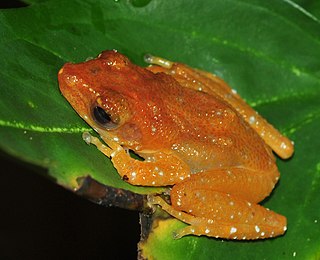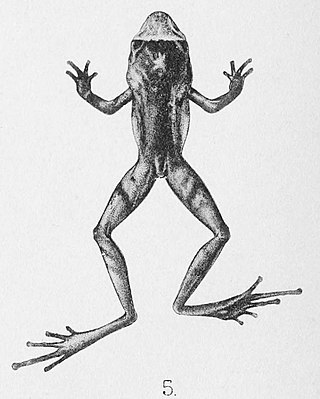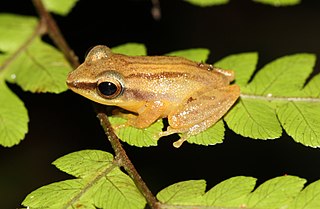Ameerega ingeri, also known commonly as Niceforo's poison frog, Brother Niceforo's poison frog, or Inger's poison frog, is a species of frog in the family Dendrobatidae. The species is endemic to the Colombian Amazon. It is known with certainty only from its type locality in the Caquetá Department. Records from the Putumayo Department ascribed to this species likely refer to Ameerega bilinguis, although other sources continue to include Putumayo in the range of Ameerega ingeri.
Leptopelis oryi, also known as the Garamba forest treefrog and Ory's tree frog, is a species of frog in the family Arthroleptidae. It is found in the northeastern Democratic Republic of the Congo, northwestern Uganda, and adjacent South Sudan. It is morphologically similar to Leptopelis nordequatorialis from Cameroon, and has also been considered its synonym, but is currently treated as a distinct species. The specific name oryi honours Albert Ory, warden in the Garamba National Park, the type locality of this species.
Kalophrynus nubicola is a species of frog in the family Microhylidae. It is endemic to Sarawak in Malaysian Borneo and is only known from the Gunung Mulu National Park. The specific name nubicola means "dwelling in cloud". Common names blue-spotted sticky frog and mossy-forest sticky frog has been coined for this species.
Meristogenys macrophthalmus is a species of frog in the family Ranidae. It is endemic to Sarawak in northern Borneo (Malaysia) and is only known from its type locality in the Bintulu District. The specific name macrophthalmus is derived from the Greek words macros (="large") and ophthalmos (="eye") and refers to the large eyes of this frog. Common names Matsui's Borneo frog, large-eyed torrent frog, and big-eyed torrent frog have been coined for it.

Nyctixalus pictus, also known as cinnamon frog, cinnamon treefrog, cinnamon bush frog, painted Indonesian treefrog, and white-spotted treefrog, etc., is a species of frog in the family Rhacophoridae. It is found in the Malay Peninsula, the Philippines, and parts of the Greater Sunda Islands.
Philautus abditus is a species of frog in the family Rhacophoridae. It is found in the highlands of central Vietnam as well as in extreme northeastern Cambodia. The specific name abditus is Latin for "hidden" or "concealed" and refers to the black spots on the legs that are concealed while the legs are flexed.

Philautus bunitus is a species of frog in the family Rhacophoridae. It is endemic to Malaysian Borneo and inhabits subtropical or tropical moist lowland forests and subtropical or tropical moist montane forests and is threatened by habitat loss.

Raorchestes griet is a species of frog in the family Rhacophoridae. It is endemic to the Western Ghats south of the Palghat Gap in Kerala and Tamil Nadu states, India. The specific name griet honours Griet Decock, spouse of Franky Bossuyt, the scientist who described the species. The common name Griet bush frog has been coined for it.

Philautus hosii is a species of frog in the family Rhacophoridae. It is endemic to Borneo and has been found at 1,351 m (4,432 ft) above sea level. The specific name of the synonym, Polypedates chlorophthalmus, refers to its "remarkable green iris", from the Greek for "green-eyed". Accordingly, the common name green-eyed tree frog has been coined for the species.

Philautus kempii is a species of frog in the family Rhacophoridae. It is known with certainty from its type locality, Upper Rotung in Arunachal Pradesh, Northeast India, in the area also claimed by China. It is also reported from Arunachal Pradesh in general as well as from extreme eastern Tibet; these might represent another species. Very little is known about this species, and even its taxonomic validity remains uncertain.
Philautus mjobergi is a species of frog in the family Rhacophoridae. It is endemic to northern Borneo and found in Kalimantan (Indonesia) and Sarawak (Malaysia). The specific name mjobergi honours Eric Mjöberg, a Swedish naturalist, ethnographer, and explorer. Common names Murud bubble-nest frog and Mjöberg's bush frog have been coined for it.
Philautus umbra is a species of frog in the family Rhacophoridae. It is endemic to Borneo and only known from Mount Api in northern Sarawak, Malaysia, although it might also occur in the adjacent Brunei.

Polypedates otilophus is a species of frog in the family Rhacophoridae. It is endemic to Borneo where it is widespread and found in Brunei, Indonesia, and Malaysia, typically in the lowlands but sometimes as high as 1,100 m (3,600 ft) above sea level. This species has prominent, sharp ridges behind the eye, above the ear, referred to in its names.
Leptomantis gauni is a species of frog in the family Rhacophoridae. It is endemic to Borneo and is found in Sabah and central Sarawak (Malaysia), Brunei, and north-eastern Kalimantan (Indonesia). The specific name gauni honours Gaun Sureng, a collector for the Sarawak Museum and a companion to Robert F. Inger on field trips when this species was observed. Common names short-nosed tree frog and Inger's flying frog have been coined for it.

Feihyla kajau, also known as the Dring's flying frog, white-eared tree frog, and white-eared jelly-nest frog, is a species of frog in the family Rhacophoridae. It is endemic to Borneo and found in all major jurisdictions of the island Kalimantan (Indonesia), Sabah and Sarawak (Malaysia), and Brunei. The specific name kajau is Berawan for "charming".
Leptomantis rufipes is a species of frog in the family Rhacophoridae. It is endemic to Borneo and known from isolated locations in south-central Sarawak and eastern Sabah and central Kalimantan (Indonesia). Common names Malaysian flying frog and red-legged frog have been coined for this species. The specific name rufipes refers to the red webbing of this frog.
Papurana attigua is a species of frog in the family Ranidae, the "true frogs". It is found in central and south Vietnam, eastern Cambodia, and southern Laos. The specific name attigua is derived from Latin attiguus meaning "neighbor". It refers to the similarity of this species to Indosylvirana milleti. The common name similar frog has been coined for this species.

Raorchestes coonoorensis, also known as the Coonore bushfrog or Coonoor bush frog, is a species of frogs endemic to the Western Ghats, India. It is reported from its type locality, Sim's Park in Coonoor, with an additional observation from Kothagiri; both locations are in the state of Tamil Nadu. Its altitudinal range is 1,780–1,850 m (5,840–6,070 ft) asl.

Sri Lanka petite shrub frog,, is a species of frogs in the family Rhacophoridae, endemic to southwestern Sri Lanka. This relatively recently described species is only known from two locations in the Galle District, Beraliya and Kanneliya Forest Reserves. The specific name tanu is Sinhalese for "slender" and refers to the habitus of this frog.
Philautus kakipanjang, also known as the western long-legged bush frog and long-legged bush frog, is a species of frog in the family Rhacophoridae. As currently known, it is endemic to Sarawak in the Malaysian part of Borneo and recorded with certainty from two mountains, Gunung Serapi and Gunung Gading. Furthermore, there is an acoustic observation from Gunung Santubong that probably can be assigned to this species. The species is probably more widespread in the mountains of western Sarawak, if not beyond.









